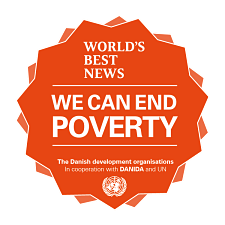1
2
3
4
5
6
7
8
How much has the so-called ‘working middle class’ increased worldwide during the last 25 years? (The UN defines working middle class as people with an income of more than 4 dollars a day.)
Which world region has seen the biggest progress towards enrolling all children in school, since the Millennium Development Goals were launched in 2000?
How are the tigers in India doing now, compared to ten years ago?
How many lives have been saved by vaccines against measles between 2000 and 2013?
How many births now take place under supervision of trained health workers?
How many mosquito nets have been distributed in malaria-prone African countries south of the Sahara, during the last 10 years?
Which world region has nearly tripled the size of its protected nature reserves?
Which of these countries has combined economic growth with poverty reduction and increased equality?

Do you find it difficult to believe in World’s Best News?
Try out the quiz and see if you know the facts
Begin
It’s more or less the same size
Photo: Gerardo Pesantez / World Bank CC BY-NC-ND
The size has almost doubled
Photo credit: Tormod Sandtorv CC BY
The size has almost tripled
Photo credit: Gavin Houtheusen DFID CC BY
3
South Asia
Photo Credit: World Bank - Curt Carnemark CC BY-NC-ND
Sub-Saharan Africa
Photo credit: Dominic Chavez World Bank CC BY-NC-ND
Latin America
Photo credit: Nahuel Berger - World Bank CC BY-NC-ND
2
Tiger numbers are down by half
Photo credit: Melanie Cook CC-BY-NC-ND
There are now fifty percent more tigers
Photo credit: Art G. CC BY-NC-ND
The tiger population is more or less stable
Photo credit: Tambako CC BY-ND
2
Approximately 15 million
Photo credit: UNICEF Ethiopia - 2010 - Getachew CC BY-NC-ND
Approximately 10 million
Photo credit: UNICEF Ethiopia - 2010 - Getachew CC BY-NC-ND
Approximately 3 million
Photo credit: Pete Lewis DFID CC BY
1
One in four
Photo credit: Hamed Saber CC BY
Two in four
Photo credit: UNICEF Ethiopia 2014 Tsegaye CC BY-NC-ND
Three in four
Photo credit: DFID CC BY-NC-ND
3
500 million
Photo credit: Arne Hoel World Bank CC BY
900 million
Photo credit: Georgina Goodwin and Vestergaard Frandsen CC BY
100 million
Photo credit: Benoit Matsha Carpentier IFRC-CC-BY-NC-ND
2
Latin America
Photo credit: Sheila Sund CC BY
Oceania
Photo credit: Markolf Zimmer CC BY NC-ND
Asia
Photo credit: Xianyi Shen CC BY-NC-ND
1
Russia
Photo credit: Rajesh Pamnani 2013 CC BY
Brazil
Photo credit: Andreas Nilsson
China
Foto: See Ming Lee / CC BY
2

1
2
3
4
5
6
7
8
You got: /
We are on the right track - and now you know how
Help us spread the World’s Best News!
See the correct answers
I got myresult out of 8 correct answers!
177051269159207
https://worldsbestnews.org/wp-content/uploads/2014/01/rosette_UK_RGB-01_opt.png
Share on Facebook
How much has the so-called ‘working middle class’ increased worldwide during the last 25 years? (The UN defines working middle class as people with an income of more than 4 dollars a day.) The working middle class has nearly tripled since 1990. This group now makes up nearly half of the workforce in developing countries. It used to be around 18 percent 25 years ago.
Which world region has seen the biggest progress towards enrolling all children in school, since the Millennium Development Goals were launched in 2000? Africa south of Sahara has seen more progress towards primary education than any other world region. The share of children in the region who go to school has increased by 20 percent in the last 15 years.
How are the tigers in India doing now, compared to ten years ago? Tiger numbers are up by about 50 percent in India since 2006. Some other well-known threatened animal species have also seen progress, thanks to conservation efforts, for example the Panda. But overall, world nature is still in trouble, and many species and habitats remain at risk of destruction.
How many lives have been saved by vaccines against measles between 2000 and 2013? Approximately 15.6 million deaths have been averted between 2000 and 2013, thanks to vaccinations against measles. As of 2013, around 84 percent of all the world’s children received at least one dose of measles vaccine.
How many births now take place under supervision of trained health workers? Three out of every four births now have health workers present. This minimises the risk of complications or death, for both mother and child.
How many mosquito nets have been distributed in malaria-prone African countries south of the Sahara, during the last 10 years? 900 million. Together with better diagnostics and treatment, this has led to a 58 percent reduction in the malaria mortality since 2000. This amounts to saving approximately 6.2 million lives.
Which world region has nearly tripled the size of its protected nature reserves? Latin America. 23.4 percent of the region’s land mass is now under some form of protection. In 1990, it was only 8.8 percent.
Which of these countries has combined economic growth with poverty reduction and increased equality? Brazil. Together with Bangladesh and Malawi, they are examples of countries that have managed to create economic growth, while fighting poverty and increasing equality, since 1990.
Back